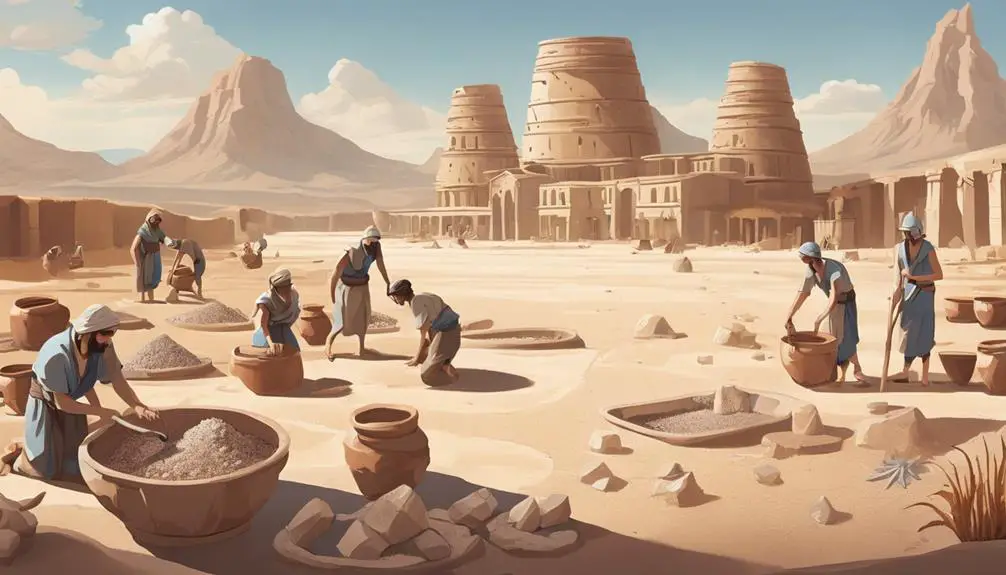Investigate the intriguing role of nitre in the Bible, a substance steeped in symbolism and ancient cleansing practices, beckoning further exploration.

What Is Nitre in the Bible
Interestingly, references to substances like nitre appear less than a handful of times in the Bible, yet they've sparked centuries of scholarly debate and curiosity.
You might be wondering what nitre is, especially within a biblical context. Historically known as a cleansing agent, its mention in scriptures such as Proverbs and Jeremiah has intrigued many to uncover its symbolic and practical significance.
By exploring the chemical composition and historical uses of nitre, you'll find yourself on a journey through ancient texts and practices, uncovering layers of meaning that could shed light on its symbolic significance in Biblical times.
Key Takeaways
- Nitre in the Bible refers to a naturally occurring mineral, not synonymous with modern chemical compounds.
- Its historical significance includes uses in preservation, food storage, and spiritual symbolism.
- Translation challenges exist due to differences between ancient terms and modern chemical definitions.
- Understanding nitre's biblical references requires insight into its cultural, historical, and spiritual contexts.
Understanding Nitre

To fully grasp the concept, it's essential to recognize that 'nitre,' mentioned in the Bible, refers to a naturally occurring mineral, pivotal in ancient societies for various purposes. Modern misconceptions often blur the historical accuracy and understanding of nitre, leading to confusion about its true nature and uses. Contrary to some contemporary interpretations, nitre in biblical times wasn't synonymous with the chemical compounds we associate with similar names today.
The production methods of nitre in ancient times were far removed from the synthetic processes you might imagine. These methods were labor-intensive, relying on the natural evaporation of mineral-rich waters or the mining of nitrate-bearing earth. This distinction is crucial for a scholarly analysis, as it underscores the technological and scientific knowledge of the era.
Understanding nitre's role in ancient societies requires a departure from modern assumptions and a dive into the historical context. This mineral wasn't just a substance but a crucial component in daily life and various industrial activities. Insight into its production and application sheds light on the technological sophistication of our ancestors, challenging any underestimation of their capabilities and achievements.
Biblical References Explained

Building on our understanding of nitre's significance in ancient times, we'll now explore its specific mentions within the biblical text and the implications of these references. The presence of nitre in the Bible offers a fascinating glimpse into the daily life and practices of ancient peoples, yet it also presents modern readers with translation challenges and misconceptions. These passages, when not carefully interpreted, can lead to misunderstandings about the substance's role and importance.
Translation challenges arise primarily because the ancient terms don't always align neatly with modern chemical definitions. The Hebrew word often translated as 'nitre' mightn't refer to what we today understand as potassium nitrate. This discrepancy can lead to modern misconceptions, where readers might anachronistically impose their understanding of nitre upon the text, missing the substance's original context and significance.
Scholarly analysis helps to mitigate these issues by examining the broader cultural and historical usage of nitre, drawing on contemporary texts and archaeological findings. This approach enables a more nuanced understanding of biblical references, offering insights into the text's deeper meanings and the everyday lives of its characters. Through careful study, we can appreciate the complexity of ancient languages and the precision required in translating these ancient texts.
Chemical Composition

Delving into the chemical composition of nitre reveals a complex substance that ancient texts, including the Bible, may reference in ways divergent from our modern understanding of potassium nitrate. This divergence primarily stems from historical terminologies and the knowledge available at the time. Today, you're familiar with potassium nitrate as a key component in various modern applications—ranging from fertilizers to gunpowder. Its molecular formula, KNO3, signifies a compound comprising potassium, nitrogen, and oxygen.
Modern comparisons of nitre's chemical composition illuminate how ancient production processes differ significantly from contemporary methods. Historically, nitre was harvested from soil rich in organic matter, where microbial action facilitated its formation. This natural process, relying on the decomposition of organic materials and subsequent mineralization by bacteria, contrasts sharply with the industrial production of potassium nitrate today. In modern settings, synthetic production processes involve the reaction of potassium chloride with nitric acid, showcasing a level of precision and predictability unattainable in ancient times.
Understanding nitre's chemical composition not only bridges historical and contemporary scientific knowledge but also highlights the evolution of production processes from naturally occurring phenomena to sophisticated industrial operations. This insight into the substance's makeup offers a glimpse into the intersection of ancient wisdom and modern science, enhancing our appreciation for historical references within a contemporary context.
Historical Uses

Understanding the complex chemical composition of nitre not only elucidates its modern applications but also sets the stage for exploring its multifaceted roles throughout history. Ancient mining practices were the backbone of nitre's historical significance. Cultures spanning from the Near East to the edges of the Roman Empire delved into the earth, seeking out deposits of this valuable mineral. They recognized early on that nitre had properties that extended beyond the mundane.
Your dive into the annals of history reveals that preservation techniques, especially in the realms of food and mummification, heavily relied on nitre. Ancient societies discovered that it could slow decay, a pivotal innovation in eras without refrigeration. This application wasn't only practical but vital for survival, allowing communities to store food for longer periods and honor their dead with more elaborate rites.
The scholarly analysis of these ancient practices sheds light on the ingenuity of past civilizations. They harnessed the properties of nitre to enhance their daily lives, from safeguarding their sustenance to venerating their ancestors. Their legacy, etched in the annals of history, underscores the enduring importance of nitre beyond its biblical references, revealing a testament to human innovation and adaptability.
Symbolic Significance

Nitre's role extends beyond its practical applications, embodying profound symbolic significance in various cultural and religious contexts. Through the lens of analytical and scholarly insight, let's explore the deeper meanings and spiritual interpretations that nitre metaphors bring to the table.
- Purification and Renewal: Nitre, in its capacity to cleanse and purify, serves as a powerful metaphor for spiritual purification and renewal. This notion resonates across different belief systems, where the act of cleansing with nitre symbolizes the removal of spiritual impurities and the rebirth of the soul into a state of purity.
- Transformation: The chemical properties of nitre that enable it to transform substances mirror the spiritual journey of transformation and enlightenment. This metaphor highlights the potential for inner change and the evolution of the soul towards a higher understanding and consciousness.
- Illumination and Wisdom: In some traditions, nitre is associated with the light of wisdom cutting through the darkness of ignorance. This symbolism underscores the role of enlightenment in dispelling falsehoods and guiding individuals towards truth and knowledge.
Frequently Asked Questions
How Does the Modern Scientific Community View the Ancient Descriptions and Uses of Nitre as Mentioned in the Bible?
The modern scientific community, through chemical analysis, views ancient descriptions and uses of nitre with a mix of fascination and skepticism. You'll find that scholars aim to balance historical accuracy with scientific understanding.
They scrutinize ancient texts, comparing them with physical evidence and contemporary chemical knowledge. This approach sheds light on how ancient societies might've utilized substances like nitre, offering you a deeper, more nuanced understanding of historical practices and their scientific bases.
Are There Any Ongoing Archaeological Studies or Findings That Support or Contradict the Biblical Mentions of Nitre?
You're diving into the fascinating intersection of archaeology and ancient texts. Current studies are indeed exploring the composition and geographical distribution of nitre, comparing these findings with historical accounts.
This research, both supporting and challenging biblical references, enhances our understanding of ancient practices and environments. By analyzing soil samples and ancient mining sites, scholars are piecing together a more accurate picture of how nitre was historically sourced and used.
How Has the Interpretation of the Term "Nitre" in Biblical Texts Evolved Over Time in Various Translations of the Bible?
You're delving into how 'nitre' has been interpreted across different Bible translations, which uncovers layers of translation challenges and cultural interpretations.
Initially, 'nitre' was understood in a specific way, but as scholars dug deeper into linguistic and historical contexts, interpretations evolved.
This evolution reflects the complexities of translating ancient texts into modern languages, where cultural nuances and scientific understanding shape how terms like 'nitre' are understood today.
It's a fascinating journey through language and belief.
In What Ways Have Different Religious Traditions Understood or Incorporated the Concept of Nitre From the Bible Into Their Teachings or Rituals?
You've probably noticed various religious traditions interpret and incorporate the concept of nitre differently. It's not just about its physical presence; it's the symbolism that counts.
Nitre's been linked to ceremonial purification, a concept deeply rooted in several faiths. This connection isn't superficial; it's a profound reflection of how symbols evolve within religious teachings.
Understanding these interpretations offers insight into the broader practices and beliefs surrounding purification in religious rituals.
Are There Any Contemporary Applications or References to Nitre in Modern Religious Practices or Ceremonies That Draw From Its Biblical Context?
You're exploring how nitre's symbolic meanings transition into modern religious practices.
It's intriguing to observe modern parallels where nitre's symbolism gets woven into contemporary ceremonies or teachings.
This exploration uncovers a fascinating blend of historical reverence and current application, showing how ancient symbols like nitre can still resonate today.
It highlights the dynamic ways religious traditions evolve, incorporating and reinterpreting ancient elements to enrich current spiritual experiences and understandings.
Conclusion
In conclusion, you've explored the multifaceted nature of nitre in Biblical contexts, from its chemical composition to its symbolic resonance.
You've seen how historical uses align with its portrayal in scripture, shedding light on the ancients' understanding and application.
This deeper comprehension underscores nitre's significance beyond a mere substance, reflecting broader themes of purification and transformation.
Your journey into its essence reveals the intricate interplay between the material and spiritual, enriching your appreciation of Biblical narratives and their enduring wisdom.



Sign up